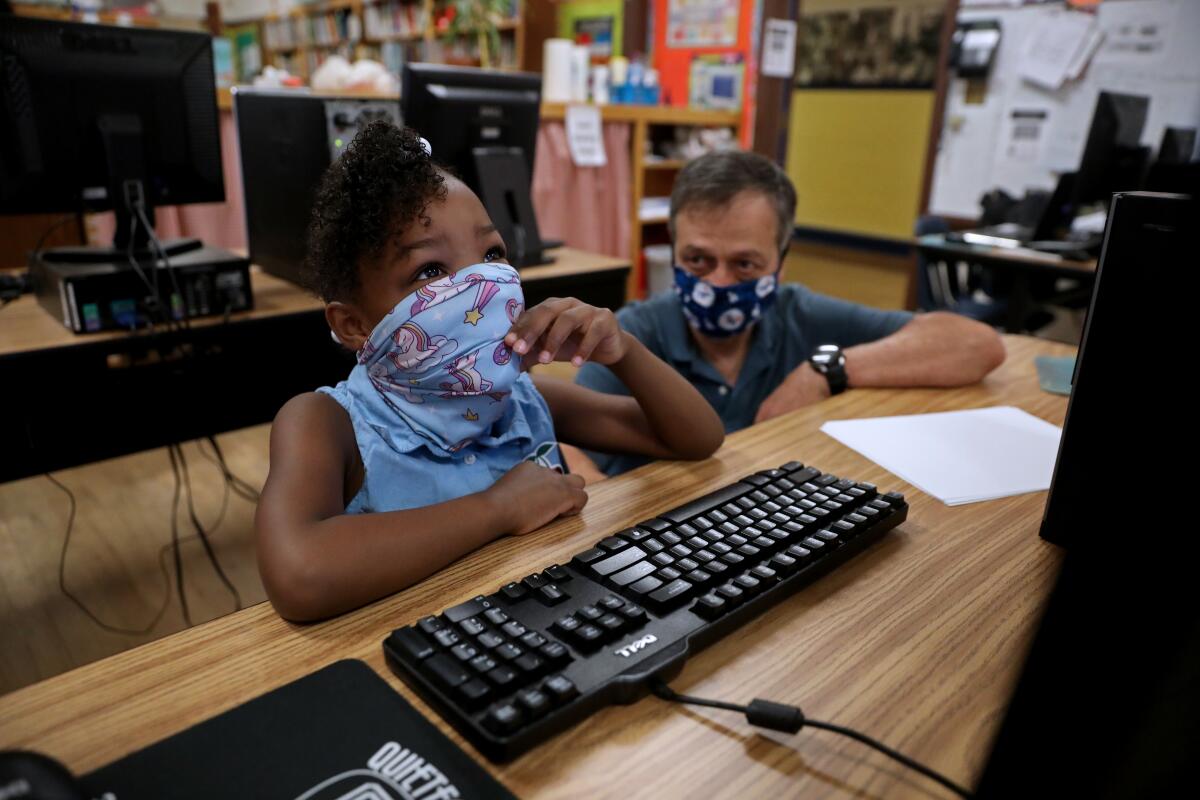Editorial: How can kids learn without homework and rigid deadlines? Quite well, it turns out

- Share via
The usual system for grading students is, bit by bit, going by the wayside in favor of one that emphasizes learning over traditional measures. It’s a healthy shift, though traditionalists no doubt are raising their eyebrows and muttering darkly about lowered standards and kids skating through school. The skepticism is especially likely now that the changes are being hastened by the realization that the current system puts students of color and those from lower-income households at a distinct disadvantage.
So-called mastery-based grading and a very similar method known as specs (for specifications) grading have been written about in academic circles for decades. But schools have stuck to an outdated system that relies heavily on students’ compliance — completing homework, behaving in class, meeting deadlines and correctly answering questions on a one-time test — as a proxy for learning, rather than measuring the learning itself.
That’s been a disservice to all students, whether they are academically gifted or struggling. It rewards students for grade-grubbing and has them feeling like failures when conditions at home — such as crowding, the need to work a part-time job to help the family finances or caring for younger siblings — make it especially hard to meet all the course requirements on a rigid deadline.
If there were a valid reason for this, that would be one thing. But obeying arbitrary and sometimes unfair rules doesn’t translate into better learning. The goal should be assessing the skills and knowledge students gained and how well they think. Mastery-based education and specs grading, and some of the elements that go with them, put the emphasis back on learning. Imagine that.
It shouldn’t matter, for example, whether students get a sterling grade on the first chapter test on human anatomy, or if they learn from their mistakes and go on to ace a second test. Students who redo an essay, even two or three times, in ways that show they’ve grasped concepts of research and critical thinking, and can write cogent and well-organized sentences, are showing that they’re gaining important skills. That willingness to try and try again until a skill is mastered is something to celebrate, not penalize with points off for multiple efforts.
It sounds vague and perhaps airy-fairy, but education experts point out that, in some ways, this kind of grading is more rigorous. Under the specs model, students are graded pass/fail on their tests, but they don’t pass unless they do well — usually at a minimum level of 80%, or a low B. There’s no passing with a C or D. It’s the opposite of skating by; students don’t move to the next level of skills with minimal grasp of the material.
Rather than being given a grade or a comment that they failed to meet a couple of deadlines, students receive specific information about their progress and what they need to do to move forward. This system transfers more of the responsibility for learning to the student.
Several states, including Vermont and Maine, already have adopted this model for their public schools. A middle school in Brooklyn, N.Y., witnessed phenomenal improvement in students’ scores on standardized tests after a few years of mastery-based learning, even though it is in ways the antithesis of a one-time, standardized test. And in case this seems like just the latest instance of touchy-feely liberal thinking limited to the Northeast, Idaho adopted mastery-based education in 2015.
The concept’s roots lie in the 1960s work of Benjamin Bloom, an education psychologist at the University of Chicago who said that given the right conditions, almost any student could achieve at high levels. Now the Black Lives Matter movement has raised awareness that traditional schools are assessing the learning of students — especially Black and Latino children — in ways that both discourage them and fail to hold them to high expectations. In addition, more than a year of remote learning has familiarized students with how to use technological tools to learn; in the classroom, those can be used to individualize instruction so that teachers have a chance to work with small groups.
The Los Angeles Unified School District is shifting toward this new model of grading this year by encouraging teachers to give kids a chance to redo tests or reports and to base grades on what students have learned, not on their work habits. It’s off to a slow start, but that’s the better way to go when introducing an era of assessment so radically different from how it’s been for the last century.
Teachers need time to understand, embrace and start incorporating these practices. And they’ll need training, administrative help and aides to help instruct small groups and track progress.
In other words, careful implementation is as important as the reform. This is where new education initiatives tend to fall apart. Too often, L.A. Unified has used changes in course and grading requirements to lower its standards. Kids can’t infinitely skip school and miss deadlines; that’s not how college or the work world operate. Students should be given extra time to learn, but the schools can’t keep a student in middle school indefinitely, while he or she builds crucial skills.
Mastery-based learning gets students to think about their own progress and encourages them to take their skills as far as they can. If done right — and not as an excuse for lack of progress — it could reinvigorate classrooms and give students a sense of control over their own educational destiny.
More to Read
A cure for the common opinion
Get thought-provoking perspectives with our weekly newsletter.
You may occasionally receive promotional content from the Los Angeles Times.










